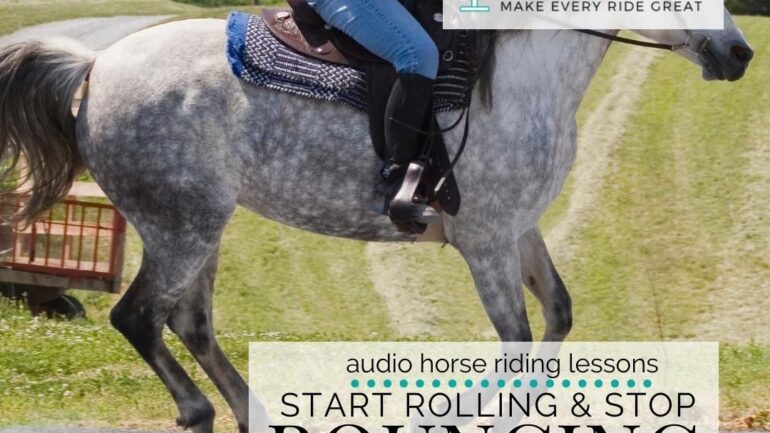One of the fun things about canter is the ‘moment of suspension’. Except when this ‘moment’ applies to the rider, not just the horse! Yes, there is a moment when the horse will be ‘off’ the ground; suspended in midair. However, we definitely don’t want you to experience this bouncing in the canter.
Becoming airborne whenever your horse strides in the canter is no fun! And the ‘land’ when you connect with the saddle again brings little relief. Instead of being a safe and reassuring place to ‘come back to earth’; it can feel like the saddle is trying to push you back into ‘thin air’ again. Never a good feeling!
In order to truly stop bouncing in the canter, I think you first have to understand the canter. And what your body needs to do in order to stay moving with the horse, rather than against it.
1. Start in Walk
I think the walk is the perfect place to really begin moving your body in a way that will help your canter. Allow the movement of the walk to move your body. Focus on how loose and supple your lower torso and seat can be. Once your body has begun moving, you can really go deeper with what is actually happening.
Instead of just thinking ‘backward and forward’ with your seat, notice the ‘higher and lower’ that goes with it. Down and forward, up and back, down and forward, up and back…
The ‘roll’ that we want to use to continue to move with our horse while cantering is just a more ‘advanced’ version of the roll you experience while in the walk. But so many riders are unconscious of this. They fail to notice all of the little nuances. Spend time in the walk. Know it with your eyes shut. And then practice some more. This will truly help you when you canter.
2. Understand the Canter
Most of us understand that there is a moment of suspension in the canter. And it is that moment of suspension that can cause so many hassles for riders! In order for you to really ride a smooth canter, every stride, it’s important to realize what is happening during the moment.
In canter, you have 1,2,3, roll. Then it repeats. The ‘roll’ part, while not an actual beat, is really a silent beat. It is where the horse resets. Meaning your horse’s body and the legs pass over the inside front leg (the 3 in the canter stride sequence). To do this, everything comes ‘up’. It lifts.
So, the down and forward happens during the 1,2,3. And the up and back happen during the ‘roll’. Like a slightly wonky-shaped circle. Down and forwards, up and back. 1,2,3, roll.
3. Self Carriage
So once you know what is happening and you’ve begun to get to grips with your seat and how it’s moving, the next part is to really carry yourself. Self-carriage is not just for horses. In fact, as riders, we should ideally be modeling this for our horses.
One of the easiest ways to really begin carrying yourself while riding is to think about your posture and your position, When you work on your posture, you will naturally engage your core – and begin carrying yourself.
And this carrying yourself is key to being able to move with your horse, rather than working against him. bouncing in the canter happens when we are moving against our horse. It’s not pleasant for horse or rider, so working on your physical strength, fitness, posture, and position will help both you and your horse in the canter.
4. Your Seat is a Pendulum
Now, while I say ‘swing your seat’, I really mean allow your seat to be swung! As you get better at moving with the canter, yes, you can definitely use your seat to influence the canter. But for the start, just to get you out of the ‘bouncing mode’, you must learn to allow your seat to move with your horse.
One of the easiest ways to think of this is that your seat is like a pendulum. It is moving backward and forwards, underneath a certain point. And that point is pretty consistent. In your case, the ‘point’ is your shoulders and upper body. Your seat is your pendulum.
Unfortunately, many riders are operating their pendulum upside down! Their shoulders and upper body is doing all the movement. While the seat is stiff, stuck, and blocking.
Being able to move with your horse in the canter will require your body to be supple, elastic, and loose enough to move with your horse through each stride of the canter. And not just the forward and back, but also the down and up. This truly creates the roll.
5. Practicing, Correcting, & Practicing
When you properly understand what is happening and can move your body, in walk, in preparation for ‘greater things’, then it is time to canter. Remember, bouncing in the canter happens on the roll. So really start to become aware of the 1,2,3,roll. When you know what your body is supposed to be doing at which point in the stride, you can make adjustments.
If you feel like you are losing rhythm and suppleness, reengage your core and carry yourself again. This will give your seat space to move with your horse.
Cantering is not easy. The more energy that is being created by the horse will always cause any weaknesses in the riders to be amplified. In this case, it’s often a lack of posture, position, and suppleness. However, these can also all be worked on by becoming intentional when you ride.
Happy Riding
Lorna
- Syncing Your Seat in Canter with Your Horse
- Developing Your Seat in the Canter
- Creating a More Responsive Transition into the Canter
- Could Poor Posture be Ruining Your Transitions into the Canter

